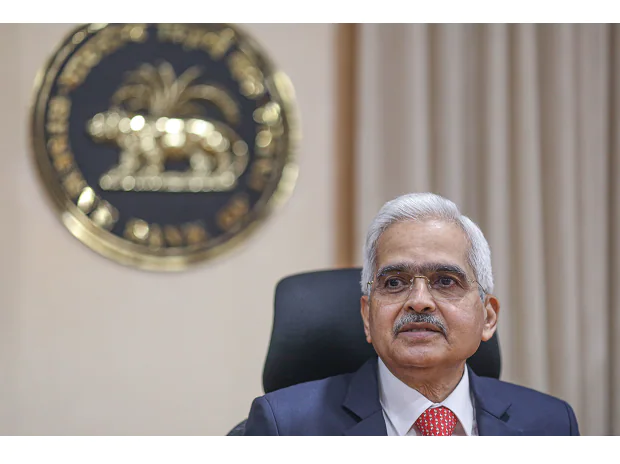[ad_1]
Given the uncertainties surrounding the global financial environment, domestic banks should raise more capital in order to be prepared for the worst-case scenarios, Reserve Bank of India Governor Shaktikanta Das said on Friday.
Das also underscored the need for banks to raise more capital to fund the demand for loans which is growing at a healthy clip.
“We have to think of the worst and do our best. We have to envisage the maximum amount of stress and do our best. They (banks) should always be prepared. Based on these analyses, banks should raise capital,” he said in an interview with Zee Business. “Another point I want to make is about loan growth that we are seeing currently. If banks are to sustain lending within this loan demand, they will have to raise additional capital.”
Das lauded both state-owned and private banks for having tapped the markets to raise funds over the past two years and said that at an aggregate level, the capital adequacy of banks was comfortable.
According to the central bank’s Financial Stability Report for June 2022, the Indian banking system’s capital-to-risk weighted assets ratio (CRAR) stood at 16.7 per cent in March 2022.
RBI regulations stipulate that banks must maintain a minimum capital-to-risk weighted assets ratio of 9 per cent. Non-bank subsidiaries must maintain the capital adequacy ratio mandated by their respective regulators.
Das also expressed optimism over the financial fundamentals of banks, saying provisioning for stressed and bad loans was “strong”.
Asked about the RBI’s views on the current strong momentum in credit demand, Das noted this trajectory was based on much lower growth in the previous year. He said the RBI keeps track of excessive lending by any sector — whether by traditional banks, NBFCs, or small financial banks.
“If there is excessive lending in any sector, we analyse it… we ask them to see if it’s too much, give us a report, and review it. Risk assessment and risk management need to be done. We caution banks from our side on risk management and risk assessment,” Das said in response to a query about robust growth in retail lending.
Acknowledging the need for better transmission of the RBI’s interest rate actions in the banking channel, Das said that the gap between deposit rates offered by banks and lending rates demanded by them was narrowing.
Citing the RBI’s withdrawal of excess liquidity as a key factor behind this phenomenon, Das predicted a further rise in deposit rates, given that banks “have pressure to raise funds”.
ALSO READ: RBI to run pilot for digitising Kisan Credit Card lending in MP, Tamil Nadu
Bank credit expanded 15.3 per cent year-on-year as on August 12, the latest RBI data showed. Deposit growth lagged far behind at 8.5 per cent during the period.
Inflation and growth
Das reiterated that Consumer Price Index-based inflation had peaked and was expected to decline to 5 per cent by April-June 2023. The RBI governor had expressed the same view at the press conference following the monetary policy statement on August 5, and subsequently in a televised interview on August 23.
CPI inflation was 6.7 per cent in July, falling below 7 per cent for the first time in four months. The RBI’s inflation target is 4 per cent, give or take 2 per cent.
According to the RBI governor, a significant portion of inflationary pressure at the current juncture was emanating from the global economic upheaval caused by Russia’s invasion of Ukraine.
Refuting criticism that the RBI was late to respond to inflation risks, Das warned against complacency when it came to tackling inflation.
He said while it was easier to provide forward guidance in a rate-easing cycle — such as the one that the RBI started in 2020 amid the Covid crisis — it was difficult, and perhaps not desirable to do so in an environment of uncertainty.
According to him, while India’s 13.5 per cent GDP growth in the first quarter of the current year was lower than the RBI’s projection of 16.2 per cent, there were signs of resilience in the economy.
“Economic activity has revived quite a bit and is recovering. We are trying to ensure the least sacrifice for growth. Industry, services, credit growth is good. Q1 GDP was lower than estimates. We are studying why. Two or three areas have been identified,” he said.

Forex reserves
Referring to the RBI’s foreign exchange reserves as the “solid backbone” of the economy, Das said they provided the firepower to maintain stability in the rupee despite global headwinds.
While the metrics for measuring reserves may vary from the level of import cover provided to a percentage of GDP, Das said that the current level of reserves was strong. “In the previous two-three years, forex inflows were huge and we had the opportunity to build them up. When inflows happen, outflows will happen. That is why we built the reserves and they are acting as a strong buffer,” he said.
With steep rate cuts in advanced economies sending yield-hungry investors to emerging markets over the past few years, in nominal terms, the RBI’s reserves rose $99.2 billion in 2020-21 and then $30.3 billion in 2021-22.
Since the Russian invasion of Ukraine in late February, the RBI has heavily drawn down its reserves. From $631.53 billion as on February 25, the headline reserves fell to $564.05 billion as on August 19. The central bank said earlier this month that reserves worth $573 billion were equivalent to 9.4 months of imports projected for the current financial year.
Das said the depreciation in the rupee over the past few months was driven primarily by a strengthening dollar and that the local unit hadn’t suffered as much as many others, including the British pound and the euro.
The rupee has weakened by almost 7 per cent to the dollar, so far, in 2022.
[ad_2]
Source link



